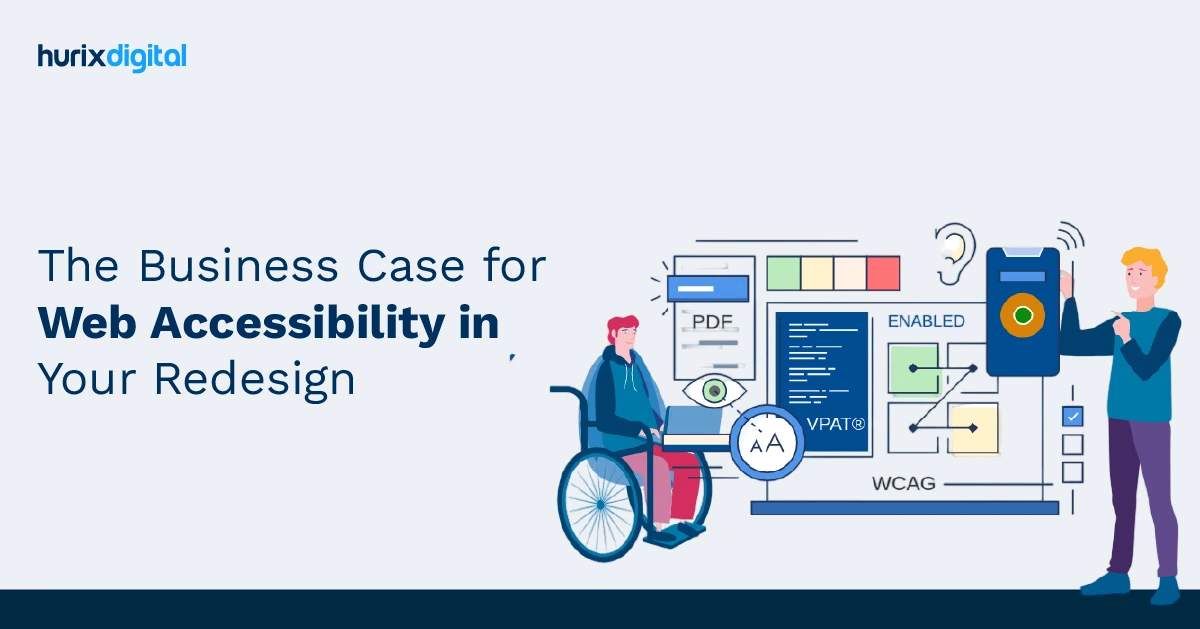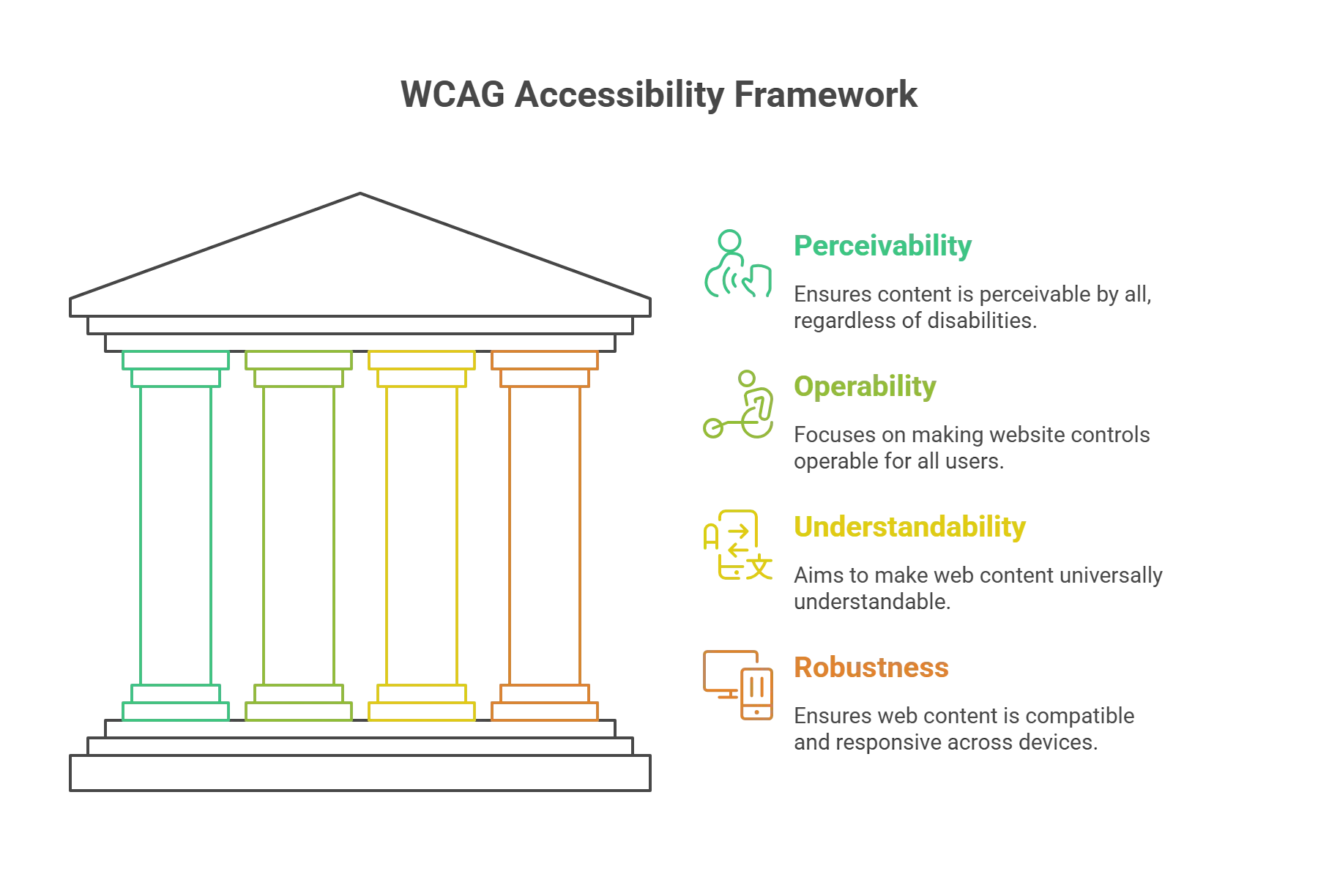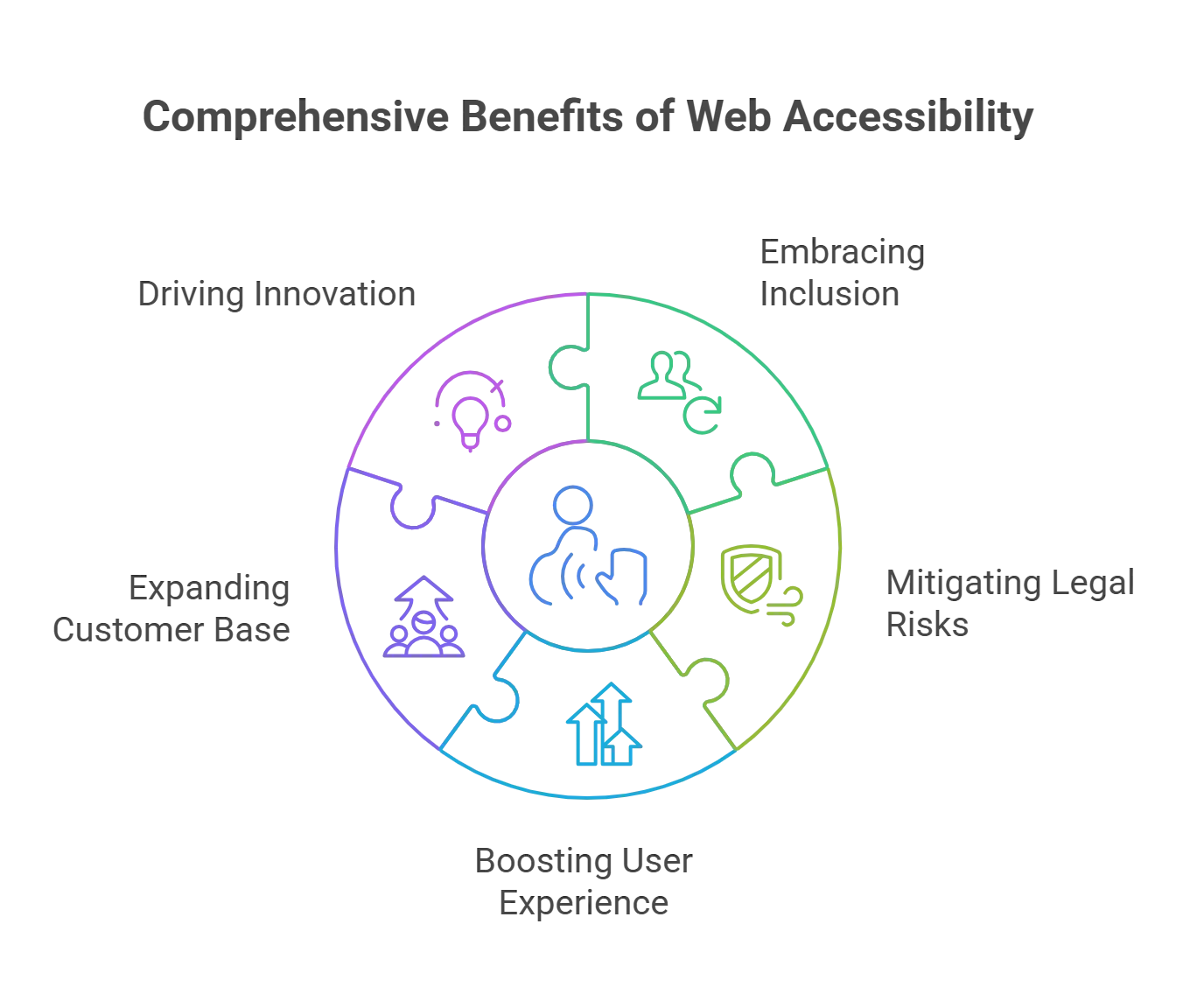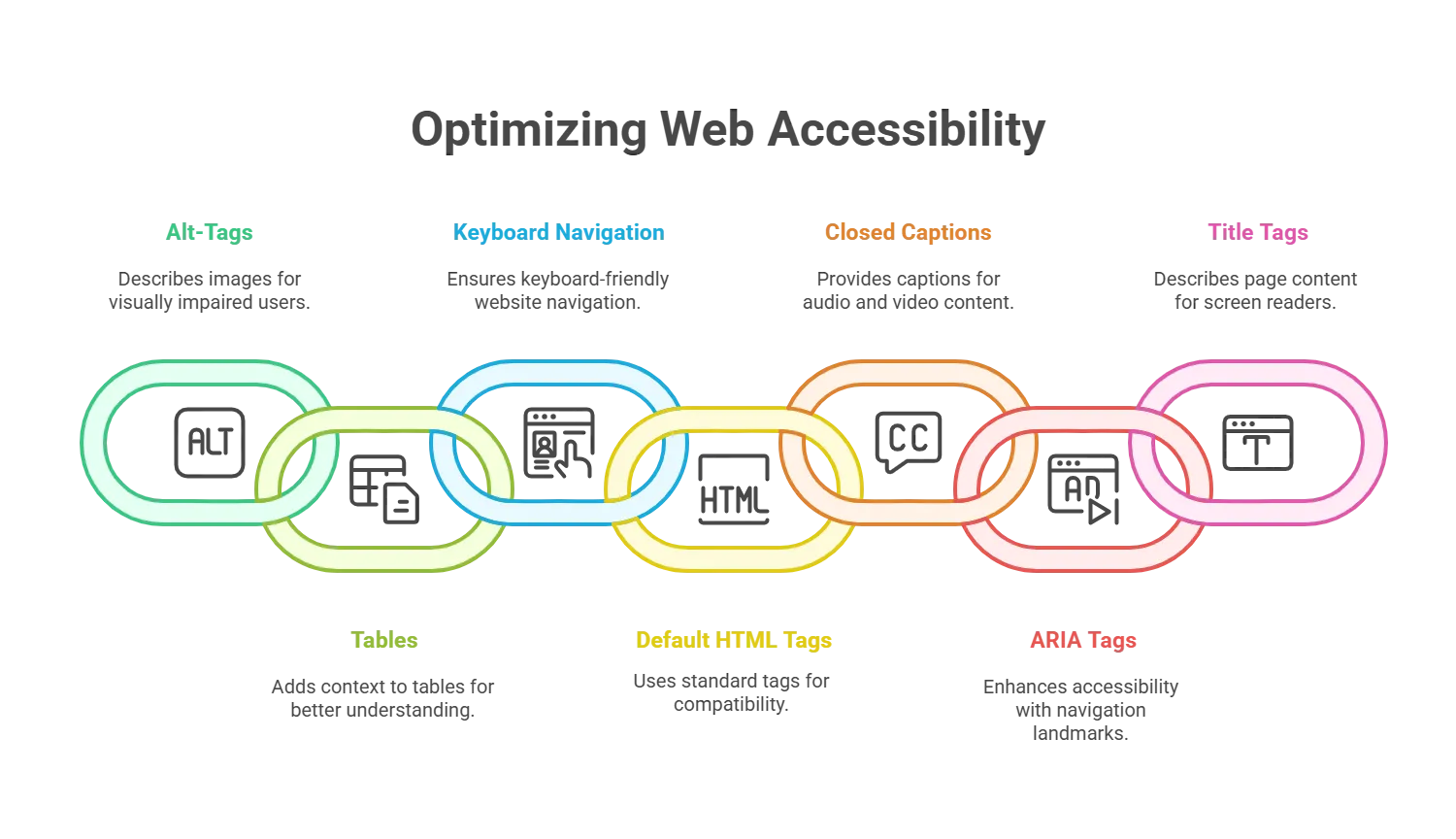
The Business Case for Web Accessibility in Your Redesign
If your business is considering rebranding or a website overhaul, you may want to ensure its compliance with web accessibility guidelines.
But why?
Before we delve into the specifics, it’s important to understand the scope of accessibility.
Over one billion people worldwide belong to the largest marginalized group- individuals with disabilities. The potential for businesses to tap into this vast market and achieve a significant return on investment is immense. However, accessibility solutions have benefits that go beyond just money.
Accessibility involves creating infrastructure – including digital infrastructure – that is accessible to everyone, including those with physical, cognitive, sensory, and situational disabilities.
With that defined, web accessibility suddenly encompasses a broad range of people who may be prevented from fully using a website.
In this blog, you will learn about the importance of businesses creating accessible websites, WCAG accessibility, and what accessibility professionals can do to help.
Table of Contents:
- What is Web Accessibility?
- What are WCAG Accessibility Guidelines?
- The Power of Web Accessibility
- Why is Web Accessibility Important?
- Benefits of Web Accessibility
- Evaluating ROI
- How Can Web Accessibility Consultants Optimize Your Website?
- The Bottom Line
What is Web Accessibility?
In layman’s terms, web accessibility is your website’s ability to be used by everyone without facing issues in consuming content.
For example, providing a text-to-speech feature for the information on your website is an accessibility feature that enables those with reading troubles, whether due to visual impairments or low-light environments, to understand the content better.
Web accessibility consultants work on various aspects of your website, like Alt-tags, keyboard-based shortcuts, and other accessibility features, to equip your website with the necessary tools to ensure it runs smoothly regardless of who uses it.
What are WCAG Accessibility Guidelines?
WCAG is the acronym for Web Content Accessibility Guidelines. These guidelines lay down the four pillars/standards for web content to be accessible equally to everyone.

These four pillars are:
1. Perceivability
Web content should be perceivable by everyone in some way, regardless of their disabilities. For example, for a visually impaired person, the website should have text-to-speech tools to perceive the content aurally.
2. Operability
This pillar helps ensure that users can operate website controls regardless of their motor capabilities.
3. Understandability
The third aspect involves making the web content universally understandable by providing translation tools, readable fonts, and infographics.
4. Robustness
Web content should be published on websites that follow web standards, are responsive, and are compatible with a variety of apps, extensions, and devices.
The Power of Web Accessibility
A comprehensive business case for accessibility should not only focus on the financial benefits but also highlight the expenses and dangers of inaction. By considering various motivating factors and implementing an integrated accessibility program, businesses can become more creative, inclusive, and compliant with international regulatory website accessibility standards.
A survey of Fortune 100 organizations found that high-performing companies frequently practice disability inclusion as part of a broader diversity strategy. If you’re a business leader or decision-maker, investing in accessibility for websites is not just the right thing to do, but it’s also a wise move that can benefit your brand, your revenue, and the clients you serve.
Why is Web Accessibility Important?
Today, the Internet is a key resource for education, health care, government operations, commerce, and employment. Especially for people with disabilities, the internet must remain accessible and user-friendly to enable them to participate and stay involved in the community.
Besides redesigning your website to make it inclusive for people with disabilities, there are several advantages to building an accessible, user-friendly site.
- Mobile optimization is essential in today’s world. Statista reports that in the last quarter of 2022, just under 60% of website traffic came from mobile phones.
- Smoother usability is necessary regardless of the quality of the internet connection available. When your website displays too many complex elements that require heavier bandwidths to load, your traffic is likely to drop.
- Since people discover websites through internet searches, improving web accessibility also helps boost your website’s search engine optimization. For example, following a website structure that indexing and crawler algorithms can easily understand helps improve website visibility in search results.
Some corporations have begun to view web accessibility improvements as a way to contribute to their corporate social responsibility.
Web accessibility is a necessity that everyone needs. From your business perspective, allowing everyone equal access to your website could capitalize on the expanded audience pool that seeks out your products and services.
Benefits of Web Accessibility
Consider the numerous opportunities ahead if you’re prepared to make a difference and unleash the untapped potential of web accessibility. In this post, we’ll examine the strong arguments in favor of having the benefits of web accessibility as a top priority for organizations, along with its numerous advantages and impressive return on investment (ROI).

1. Embracing Inclusion
In an ever-connected world, inclusivity is no longer a mere option but a necessity. Addressing diverse limitations requires a range of actions. Picture this: 300 million people worldwide, nearly the population of the United States, are color deficient. Websites must speak to blind users through text readers, while visually impaired individuals need adjustable fonts and vivid colors.
Subtitles and sign language videos make audio content accessible to those unable to hear. Making your website accessible to everyone, regardless of their abilities, fosters equal opportunities and inclusivity. A genuinely holistic user experience aligns with moral principles while consolidating your brand reputation and customer loyalty.
2. Mitigating Legal and Reputational Risks
Ensuring website accessibility is not just a question of good practice but also a legal imperative. 11,452 federal lawsuits were filed in 2021, a record number of ADA Title III claims. Surprisingly, roughly 2,500 of these cases in 2020 centered on inaccessible digital information on websites.
In addition to the financial risks of litigation, non-compliant businesses may be subject to several lawsuits for accessibility violations. Laws worldwide, such as the Americans with Disabilities Act (ADA), emphasize the need for digital accessibility to safeguard the rights of individuals with disabilities. A surge in digital accessibility lawsuits under the ADA Section 508 emphasizes the significance of prompt and accurate addressing of web accessibility problems to avoid legal repercussions.
Failure to comply with website accessibility standards and disregarding the rules can expose businesses to litigation risks and complaints, which can be detrimental to their finances and reputation.
3. Boosting User Experience and Engagement
The benefits of Web accessibility solutions encompass accommodating those with disabilities and beyond by enhancing the overall user experience for everyone. Develop a seamless and pleasurable experience while allowing users of all abilities to navigate the website with ease by:
- Adopting inclusive design principles
- Adhering to internationally recognized website accessibility standards, including:
- Intuitive navigation
- Legible text
- Alternative media formats
- And more!
The Web Content Accessibility Guidelines (WCAG 2.1) is a set of standards and methodologies created to assist designers and developers in rendering digital content accessible. Web accessibility compliance fosters positive engagement and encourages extended browsing sessions, boosting conversions.
4. Expanding Your Customer Base
According to WHO statistics, 15% of the global population has a disability. By implementing web accessibility, you tap into this vast market, reaching potential customers who might have previously faced barriers to accessing your products or services.
According to research, 86% of people prefer companies that cater to all users, and 64% are even willing to invest in them. Unfortunately, many disabled customers face difficulties accessing websites due to cluttered pages, problematic CAPTCHA tests, and confusing navigation. An enormous 71% of them will leave and turn to their competitors.
It is crucial to prioritize accessibility solutions to avoid missing out on a large portion of potential customers and to build a brand that resonates with everyone.
5. Driving Innovation and Differentiation That Sets Your Business Apart
When accessibility becomes an integral part of the design, it breaks down barriers and unleashes innovation. Prioritizing accessible design thinking fosters diverse and flexible ways for users to interact with websites and applications, benefiting disabled and non-disabled individuals.
It goes beyond screen-focused experiences, delivering human-centered, natural, and context-aware interactions. Accessible design empowers content to adapt flawlessly across various devices, platforms, assistive technologies, and operating systems.
Let us take inspiration from a remarkable example like Apple’s VoiceOver on the iPhone, a testament to how inclusive design principles often lead to ground-breaking solutions that benefit not only individuals with disabilities but society as a whole.
As touchscreens emerged, Apple recognized the impact on blind customers and dedicated years of effort to developing the world’s first gesture-based screen reader. Their commitment paid off, with Apple receiving well-deserved recognition from the National Federation of the Blind within weeks of launch for designing the pioneering and fully accessible touchscreen interface.
Evaluating ROI
It might be challenging to pinpoint the precise ROI of web accessibility because it depends on measurable and intangible elements. The advantages, however, are evident and influence a positive return on investment:
- Improved conversion rates
- Enhanced customer loyalty
- Mitigated legal expenses
- Improved brand perception
Before integrating accessibility into websites and apps, initial audits, marketing, and training investments are necessary. However, the long-term advantages considerably exceed the disadvantages.
Investing in web accessibility compliance and functionality enhances operational efficiency, as e-commerce carries lower acquisition costs and transactional expenses, resulting in higher profit margins and reduced liabilities. With ADA website accessibility, your business appeals to a larger audience while gaining visibility and credibility from search engines.
How Can Web Accessibility Consultants Optimize Your Website?
There are several ways that you can fulfill the accessibility requirements for websites. By partnering with reliable accessibility professionals, you can optimize the following aspects of your digital channels:

1. Alt-Tags
Alt tags are used to describe the images that you post to your website. These descriptions allow screen readers to read an image’s content for people with visual impairments. This aids everyone in understanding the visual content of your website.
2. Tables
Accessibility professionals help you add captions to tables and give them “scope” so that the tables have context rather than just being a collection of rows and columns.
3. Keyboard Navigation
Your website’s design should be friendly for users who only use keyboards for navigation. Avoid adding excessively animated elements and requiring mouse pointers to trigger further action. Provide dropdown menus that can be operated through the keyboard.
4. Default HTML Tags
Using default HTML tags for website elements is always more functional. For example, the default tag for a button should not be repurposed into an anchor because it’s not compatible with the software used by people with disabilities to read a website. It can be confusing and generate garbled information.
5. Closed Captions
For audio and video elements on your website, closed captions enable your visitors to view the content when they can’t turn the volume up. It’s helpful for people with hearing impairments.
6. ARIA Tag
ARIA is the acronym for Accessible Rich Internet Applications. These tags provide better accessibility for people with disabilities by enabling navigation landmarks, error messages, hints, and live content updates. They also provide form descriptions to help people fill them in.
7. Title Tags
Titles and tab titles describe the page’s content. They make it easier for screen readers to describe a page to the viewer.
The Bottom Line
Eliminating discrimination from our creations is vital to thriving in the digital ecosystem. Building accessible websites can save businesses money over time and prevent expensive lawsuits. Additionally, designing products expressly for those with impairments is crucial for guaranteeing usability and accessibility.
Considering the legal repercussions of ignoring accessibility, coupled with mandatory compliance with local laws, many businesses have incorporated an accessible design into their procedures. Integrating accessibility solutions enables organizations to dismantle obstacles, make digital assets inclusive, and reap the benefits of a varied and accessible society.
Contact Hurix Digital’s dedicated team of certified professionals to ensure your websites and mobile apps meet accessibility standards.

Vice President – Content Transformation at HurixDigital, based in Chennai. With nearly 20 years in digital content, he leads large-scale transformation and accessibility initiatives. A frequent presenter (e.g., London Book Fair 2025), Gokulnath drives AI-powered publishing solutions and inclusive content strategies for global clients




